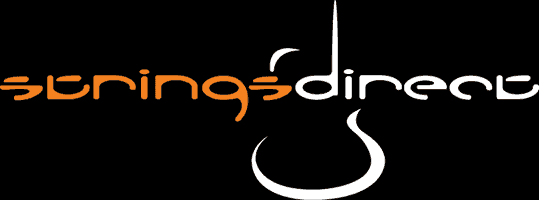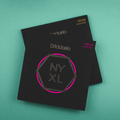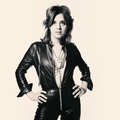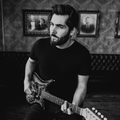PETE TOWNSHEND
By Strings Direct – 29 August, 2023
PLAYER SPOTLIGHT
“The day you open your mind to music, you're halfway to opening your mind to life."
"Pop Chronicles", Show 23, May 02, 1968. Pete Townshend
"

As we look ahead to the dawn of a New Year we reach out with much optimism, we bring our focus and attention to a true British icon who has just the musical medicine to bring hope and light.
Spokesman for a generation and a creative poet whose musical achievements have not only stood the test of time but also revolutionised the youth during their place in time. 🕰
We look at a player who is both a songsmith and a bonafide guitar hero, instantly recognisable in both image and sound this guy is of great stature in the six string world. One of the key creatives throughout the British Invasion '60s Boom
“The Windmill” that continues to blow our minds 🎯
Be upstanding for Mr Pete Townshend. 🎸

Artistic Adolescent
Let’s take ourselves back to a time when the Germans had just surrendered and new promise and better futures loomed. May 19th 1945 in Chiswick, London an artistic mastermind was born. Peter Dennis Blandford Townshend 🇬🇧

Born into a family life of two professional musicians Peter was very much destined for a creative future. His father Cliff was a professional alto saxophonist and was part of the Royal Air Force dance band “The Squadronhaires”. His mother, Betty, was an accomplished and respected singer appearing with “Sydney Torch” & “Les Douglass Orchestras”.
Peter’s parents led a volatile marriage; they both drank heavily and had fiery tempers, which almost became part of the territory of being full-time gigging musicians and performers… the pressure was clearly reflecting into their relationship.
His parents eventually split mutually due to continued unrest from both parties; Peter was only a toddler at this time and he was sent to live with his grandmother Emma Dennis, a relative Peter would reflect on as “Clinically insane”.

After a two-year separation his parents moved back into a house in a middle-class part of Acton. It was predominantly Polish and Jewish, this situation somewhat isolated a young and impressionable Peter, that would in someway fuel and ignite his long term creativity.
A large part of his boyhood years was spent reading escapism novels such as Gulliver's Travels & Treasure Island. He enjoyed time away with his parents to the seaside and the Isle of Man, it was on one of the trips Peter discovers the film “Rock Around The Clock” which sparked a lifelong fascination with American Rock 'n' Roll. 🎶
His first experience of a concert was watching Bill Hayley perform in London, this was a massively inspirational and a truly imprinting experience.
His first instrument was given to him by his grandmother for Christmas in 1956. It was a basic Spanish classical guitar and his father initially showed him a few chords to go forward with. Townshend was then completely self taught through his own perseverance and never learned to read music - which was quite uncommon then as music lessons and the theory of music alongside reading was very standard.
What really is exceptional and something we can discover from Pete is his exquisite understanding and appreciation of harmony.
We hear him speak about harmony and it’s relativity to overdriven guitar sounds in the clip below:
Townshend’s first musical venture was with school pal John Entwistle, a familiar name to us in a previous spotlight 😉They formed a short-lived jazz group called 'The Confederates'.
A few basic shows were played locally, but the increase in popularity and rise of rock ‘n’ roll saw Townshend drift away - in conjunction with having a disagreement and a fight with the group's drummer. 🥊
Detour To The Who 🎯
Late 1961 saw the early development of one of the most iconic bands in British music. 'The Detours' were a skiffle/rock 'n' roll band... Lead by the larger-than-life Roger Daltrey and bass driven by Entwistle.
It was suggested Townshend join as rhythm guitarist, this would be the roots of what would become 'The Who'.

Once fully formed this band became one of the most iconic and era-defining musical statements of their time.
Forerunners in the British Invasion and fundamental to the mid-'60s Mod movement into 70’s arena rock, The Who were spokesmen for their generation and an undeniable powerful force in music & fashion at the time. It was a combination of artistic angst and progressions of R&B structures.
In the early days the band were known for their teenage anthems and reflectively identifying with the modern youth.
Throughout the development of the band they were always experimental and Townshend was the driving force pushing new sonic capabilities into the band incorporating PopArt and conceptual ideas which led to the birth of the Rock Opera.
Pete is now regarded as one of the finest British songwriters and artistic creatives of our time.
The iconic guitar style and theatre injected into both their live performance and overall persona was awe inspiring and pretty much ground breaking.
Townshend has conveyed in many interviews that his now iconic guitar moves such as the Windmill and the powerslide were all just his expressions artistically to the contextual body of work he was producing at the time known as the sound of The Who.
As a guitar player Pete stands the test of time as a true guitar hero and instantly recognisable icon, in a world full of eccentric and revolutionary guitar players, he was and still is individual in his own way dramatically and charismatically but most of all destructively 💥

String Timeline 🎸
Over the many player spotlights we have featured there are different levels of detail that players will go into or their technicians will let on in regards to what strings and why... . However, the following detail we have discovered here on Pete Townshend is absolutely astonishing 🤟 it’s like a history of string use and changes, like a diary or a timeline if you will. It's been formulated perfectly and reads like a manual!

Here at Strings Direct this is the sort of thing dreams are made of when we find this type of information! We have copied in the entire document for your digestive reading pleasure.
It really is a great read and makes sense in many ways, as you are of course aware Pete Townshend was no light player and he hit the guitar hard with real teenage angst.
Pete goes into good detail as to why light strings are just no good for him and how heavy strings are there to serve their purpose.
As we can see he’s evolved with different brands, different string choices, and different gauges as he’s gone on. Check out the two sets we have made up for you from different eras to give you a flavour of Pete Townshend and “his generation” 🇬🇧

Pete’s Guitar Strings
1964–1967 – Tape-wound Rickenbacker strings
For Rickenbacker guitars, Pete likely used tape-wound Rickenbacker guitar strings.
Likely configuration for 12-strings:
- .010/.010
- .013/.013
- .020/.010
- .026/.013
- .034/.020
- .042/.026
Likely configuration for 6-strings:
- .010
- .013
- .017
- .026
- .034
- .042
1967 – Fender strings
Documented for 1967 is Pete’s use of Fender strings. In 1967 and 1968 on Fender Stratocasters, he likely used Fender pure nickel wrap #1500 Spanish Guitar [Smooth Round Wound]. These sets were standard issue on new Fender guitars 1966–1969.
- .012
- .016
- .016p (substituted for .026w)
- .034
- .044
- .052
Pete likely substituted the .016 (plain) for the set’s .026 (wound) for the G string, as was a common for British guitarists in the early to mid ’60s, a practice Pete would continue into the ’70s with his Gibson guitars.
All quotes and references are copyright their original owners and are included for reference only.
From Guitar Player, October 1967
Excerpts from an interview with John Entwistle and Pete Townshend conducted June 18, 1967, in San Francisco, just prior to the Who’s appearance at the Monterey Pop Festival.
GP: Picks and strings?
Entwhistle [sic.]: We both use Herco heavy-gauge nylon picks. And I use Roto-Sound heavy-gauge wirewound strings; they’re only available in England.
Townshend [sic.]: I use regular Fender Strings.
It is also possible that, for the recording of Tommy, when using the Fender Electric XII 12-string guitar (as heard on Sparks, Underture, etc.), that he used Fender’s electric 12-string nickel-wound set: #1450 12-STRING GUITAR:
- .010/.010
- .013/.013
- .022w/.010
- .026w/.013
- .034/.016
- .044/.022w
Fender Catalogues
Below are scans of Fender catalogues circa 1966 and 1969, courtesy Hal Rollins <hal526@mindspring.com> and Steve Barr <vintgebass@aol.com>.
1968–1982 – Gibson 340 Sonomatic strings
Gibson 340 Sonomatic .012 strings (with a .016 for both B and G strings):
A set of Gibson 340 strings of Pete’s from early ’70s, courtesy rockstarsguitars.com.
- .012
- .016
- .016
- .032
- .044
- .056
Beginning 1976 or earlier, the strings are changed every set on the primary instrument by Alan Rogan. An .018 is used for the G string:
- .012
- .016
- .018
- .032
- .044
- .056
All quotes and references are copyright their original owners and are included for reference only.
From May/June 1972 Guitar Player
GP: In your string setup, I imagine you would select a heavier gauge on the bottom and a lighter on the top because of your combination lead and rhythm playing?
PT: No, that’s the setup you get when you buy a regular gauge Sonomatic set, but I use a .056, .044, .032, .028, another .028 and a .022 [Whotabs:this is a typo — it was actually .056, .044, .032, .016, .016, .012.] for the top. It’s a heavy set and it’s heavier at the top, relatively, than it is at the bottom.
GP: You like the pull more than the slinky feel?
PT: Yeah, if I’m going to hit a note or bend it, I really want to have to struggle for it, because I’m so physically wound up on the stage. If I wanted to, I could pull the string up and break it with my hand. it’s really weird, when I’m in the dressing room playing, I can hardly stretch the strings, and then when I go on stage I get a buzz and the strings feel slinky, they really feel slinky. The first guy that I met — my idol in England, was a guy named Mickey Green, who used to play with Johnny Kitten [sic; Kidd] and the Pirates, and he was the first big note-bender, particularly on the G. And you’d freak over Jimmy Burton and you’d freak over Mickey Green and you wondered how they got that sound. Went to see a guy about it and he said it was the thin G, he uses like two 2nds instead of a G, right? So I got my guitar and I really got into it. I got to see Mickey play, and I went back stage to see him and I asked him if I could play his guitar and he said, “Sure, man.” I picked it up, and he’s got strings like bloody piano strings, they’re huge! And the G isn’t plain, it’s wound, and he used to stretch it practically to the A string and beyond. Big hands, and he would pull it down and tuck it under as well. That’s what really buzzed me out, using the heavy strings, ’cause a lot of younger guitarists tend to get the light strings and they get into quickbending riffs, and all those Jeff Beck trips. But it’s like the fretboard and the pickup doing it and you’re just piddling about. Freddie King, who is my man at the moment, does a bend and he’s pulling it a good inch to get that sound, he works for it. If you’re going to bit a note, you’ve got to work for it. Leslie West, who is another amazing guitarist, he hits them. He gave me an old Les Paul Junior once, like the kind he uses and it was strung like the way he uses it, and his strings are not particularly very light. They’re a bit lighter than what I use, but not much.
GP: Why the two .028’s for both the G and B strings?
PT: I like them because if I stretch them with those two fingers, if I hit say an A and stretch the G and B up like that, when I get to a certain point they go from a major to the major fifth, in tune. And if the gauges are wrong they stretch differently, and I have to separate the fingers to get them in tune, maybe I have to push the G a bit more than the B or something.
From April 1980 issue of Sound International article, courtesy Joe G’s site.
[Referring to the SG Special:] They just brought out a new model and this was in 1968 and it had a slightly larger wound pickup and it really suited my amplifiers. I started to use those and they were a bit weak, which was the only problem; I could actually break them with my bare hands. But that’s when I started to develop that technique because you didn’t need a tremolo arm. You could do it by just shaking the guitar. I got into this thing also of temper tuning the guitar with the second string flat, and pulling back slightly on the guitar all the time to bring it into pitch. So using that on some of the higher chords where you wanted that second string to voice a bit flat, you could relax the guitar and it would come out a bit flatter. No, sorry, I meant the G string. When you’re using a lighter G — I’ve never used light gauge strings. I’ve always used heavy strings — you can do that. The top string (high E) is an .012 downwards and I use two Bs instead of a B and a G string. I got that from Jimmy Burton, that’s what he used to use. I can’t stand light strings, you don’t have to struggle for it. Mickie Green, who is a guy who used to play with Johnny Kidd and The Pirates, was a great experimenter with the Jimmy Burton technique. He used to have this great lyrical string bending thing going on and I went up to him one day and said, ‘What kind of strings do you use?’ and he said, ‘What?’ And I said, ‘Do you have a plain third?’ And he said, ‘A plain what?’ He just had big hands; he used to bend the third, a wound third, right up and over the back of the neck. That was an affirmation to me that if you wanted to do it you fought for it. I hate that guitar sound where people sound like they can bend the string just by kind of thinking about it.
I [now; circa 1980] use Gibson Sonomatic strings, medium gauge. It’s and .012 on the top, .016 for the B, .018 for the G. I don’t use two Bs anymore. I’ve started to make the G a bit heavier.
Pete Townshend Tour Used Guitar Strings
Photo: Julien’s
Julien’s Auctions “Music Icons 2018” on 19 May 2018
A group of 12 guitar strings, one in original Gibson packaging, used by Pete Townshend while performing with The Who on The Who Tour 1971 in the United Kingdom. Accompanied by a copy of a letter of authenticity from Bill Holdsworth, a roadie on the tour, and a certificate of authenticity from Tracks Ltd.
Packaging, 3 1/2 by 3 1/2 inches
Estimate: $800–$1,200
Realised: U.S.$875
1989–present – Ernie Ball strings
Ernie Ball nickel-wound strings feature nickel-plated steel wire wrapped around tin-plated hex-shaped steel core wire.
1989
Ernie Ball Light Gauge Nickel-Wound .011–.052 strings:
- .011
- .015
- .018p replacing .022w
- .030
- .042
- .052
1996–1998
Ernie Ball nickel or D’Addario strings:
- .011
- .015
- .018
- .032
- .042
- .052
1999–2006
Ernie Ball .011–.052 nickel strings:
- .011
- .015
- .018
- .032
- .042
- .052
2005 (possibly)
According to Ernie Ball Artist Relations, Pete is using Ernie Ball Skinny Top/Heavy Bottom #2215:
- .010
- .013
- .017
- .030
- .042
- .052
2014–16
A case of Ernie Ball PT Custom strings (.010, .013, .017, .026, .036, .048).
(via TalkBass)
Ernie Ball RPS Slinky Nickel-Wound #2240 (with .048 replacing .046 E string):
- .010
- .013
- .017
- .026
- .036
- .048
Stage acoustics
1989
Ernie Ball bronze medium .013–.056 strings.
1996–1997
Reported as D’Addario .011 (likely .013)–.056 strings.
2000–present
Likely .013–.056 or .012–.054 Ernie Ball strings.
In 2005, according to Ernie Ball Artist Relations, Pete is using Ernie Ball Regular Slinky #2146 Acoustic Phosphor Bronze strings:
- .012
- .016
- .024w
- .032
- .044
- .054
As of 2005, Alan Rogan reports Pete is using D’Addario EXP19 (.012–.056; Light Top/Medium Bottom) phosphor bronze strings on his J200 acoustics. (Thanks to Kenny Freed)
- .012
- .016
- .025w
- .035
- .045
- .056
Alan Rogan discusses Pete’s use of D’Addario strings on his Gibson J-200 stage acoustics.
https://www.thewho.net/whotabs/gear/guitar/strings.html#s1989

* * * * *
REFERENCES
https://www.thewho.com/
https://www.allmusic.com/artist/the-who-mn0000577627/biography
https://www.guitarworld.com/artists/pete-townshend-get-the-guitar-sound-and-style
https://www.imdb.com/name/nm0870175/bio
https://en.wikipedia.org/wiki/Pete_Townshend
https://www.thewho.net/whotabs/gear/guitar/strings.html#s1989
thewho.net
ernieball.com





